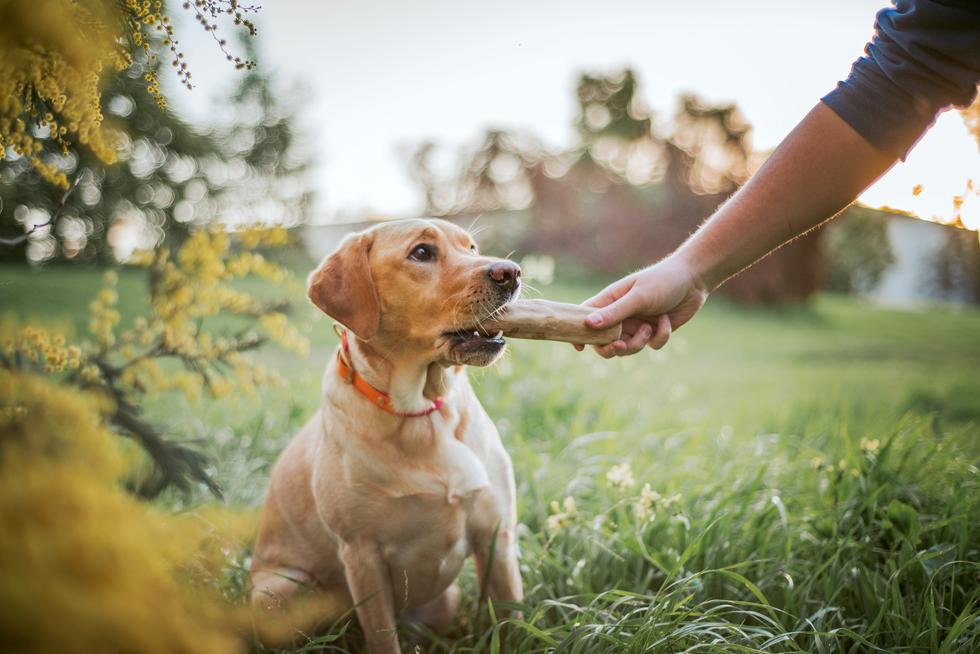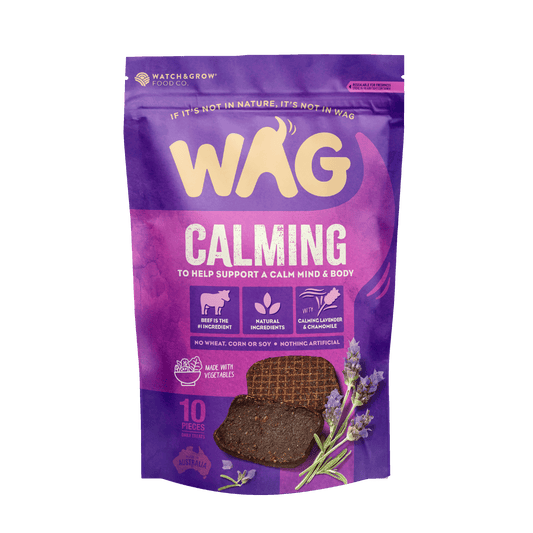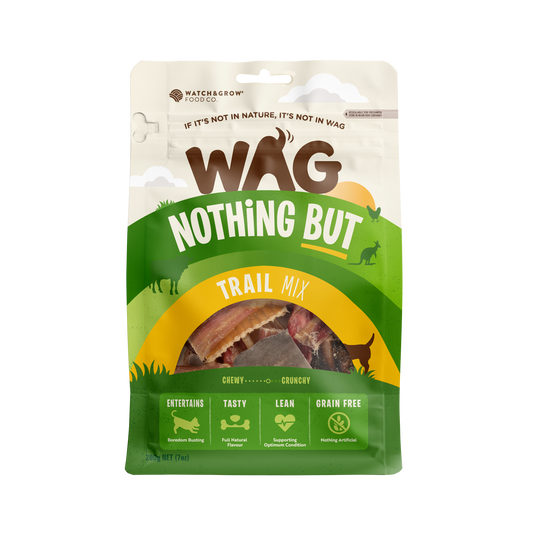10 tips for training your dog from trainers around Australia

If you’ve ever owned a dog the chances are you’ve come across some form of training in your life. And with pet ownership soaring during the pandemic, making sure dogs are properly trained and socialised is more important than ever.
So, whether you’re new to dog ownership or just need a refresher, we’ve teamed up with three expert trainers to give you a guide to the ins and outs of dog or puppy training.
Who are our trainers?
Over the month of July 2021, we’ve been working with Mel Ritterman from Cooper and Kids, Shelby Huckstep, who you might know from the Instagram account @_hollythelab, and Sophie Allan from So Help Me Dog.
At Cooper and Kids, Mel specialises in creating safe, happy and positive relationships between babies, kids and dogs. Mel is an IAABC accredited dog trainer, a Family Paws® Parent Educator and a busy mum to three young children and her Golden retriever, Cooper. So, she absolutely understands the chaos and the juggle that comes with running a busy house with kids and dogs together.
Mel is passionate about helping expecting families prepare their dogs for life with a baby or toddler. She also offers help to families wanting to introduce a new puppy or dog into the home, as well as support to families who are struggling with the child and dog dynamic. Mel uses force-free, positive, science-based training and loves helping to educate families on this too. Mel is a member of the PPGA and the APDT.
Shelby Huckstep is currently completing her certificate in dog behaviour and psychology, and works full-time as a dog walker and handler. She has also completed up to her expert trick title with her dog Holly, who you might know from the Instagram account @_hollythelab. Shelby has also been training Holly as a medical assistance dog, which she has been working as for the last two years.
Sophie has been training dogs and dog behaviour for 6 years and runs Sydney training company So Help Me Dog. Sophie and her team specialise in reactivity, separation anxiety, and puppy development, and are passionate about rehabilitating dogs and helping owners and their dogs meet their goals together. They strive to provide the best education and knowledge for each owner and their dog, firmly believing that every dog is unique, which makes every training session different.
Together with her crew of professional handlers and qualified dog trainers, Sophie uses positive reinforcement in her training. They’ve even been running zoom sessions during COVID, helping you understand why your dog might be doing certain behaviours, and how you can decrease undesired behaviours.
So, without further ado, here’s what we spoke to our trainers about.
So, why is training so important?
Mel: Training is a great way to build and strengthen a relationship with your dog. Training teaches a dog manners and gives the owners tools to be able to use to help them, and to help the dog. In some cases, training can even save your dog’s life (calling them to "Come" before they run on a road, for example).
I don’t believe in ‘training’ a dog for the sake of it. I think training is important when done and used correctly. I don’t like to train dogs to be robots, I like to train skills that are going to be helpful to both the family I am working with and to the dog in front of me.
Shelby: For me training is such an important way to build a relationship with your dog. Whether this is through obedience training, tricks, or working towards a sport, training your dog helps to create such a strong bond between you. Having a dog that has a solid foundation of training makes life a lot easier. There are so many benefits to working on training with your dog that will improve on the relationship that you have.
Sophie: Training is an essential part of owning a dog. It helps us build a bond with our dogs, teach communication, build confidence, and provides mental stimulation for them. Throughout life dogs are always learning, so this means we should always be teaching and training.
How stimulating is training for dogs?
Mel: Training is a form of enrichment and mental stimulation. Enrichment is SO important for all dogs. Enrichment is literally a way of making your days more exciting. So yes, training is stimulating for our dogs, it gives them something fun and exciting to do in their day. It works their brains and gets them thinking which is something all dogs need. Plus, dogs love getting it right and being rewarded for it!
Shelby: Training with your dog can be one of the best ways to engage them and tire them out. Short training sessions can be just as effective at burning your dog’s energy as going for a walk around the block can be. Watch your dog after you’ve done a good quality training session that has engaged both you and your dog, and you will see how much they have gotten out of it.
Sophie: Training is very mentally stimulating for our dogs. Physical exercise is important, but mental stimulation is just important! The more they think, the more tired they become as they are focusing, learning, and concentrating.
What are some of the best tips for training?
Mel: Keep training fun, positive and short. Always use food when training a new skill. Always train new skills in the least distracting environments. Reward the behaviours you want to see more often, and they will start happening more. Don’t get angry when they get it wrong. Set your dog up for success and help them to get it right or go back a step and make it easier if they aren’t getting it. And lastly, finish a training session on a high. We all have good days and bad days, and so do our dogs. If your dog just isn’t in the mood or is ignoring you, stop.
Shelby: Patience, patience, and more patience. Training isn’t a sprint, and every dog works and learns differently. My biggest advice is to always focus on training the dog in front of you and not comparing yourself to others around you. There are things that your dog may pick up super quickly and others that will take more time, and that is something that changes with each dog.
Sophie: I love the saying "teach it before you need it", which means practice frequently what you'd like the dog to do, so when you need it, your dog knows the drill. My best tips for training are practice, repetition, high value treats, and practicing in less distracting environments.
How often should you train?
Mel: There is no rule with this one. Realistically, our dogs are learning all the time. Training should be a fun activity when everyone has the time and energy to be focused and present in the moment.
Shelby: I believe that it is more effective to do short training sessions a few times compared to longer sessions. This gives both you and your dog time to absorb what you are working on, and also prevents getting frustrated or tired as quickly.
Sophie: There are many variables with training; the environment, the breed, genetics, past learning, and experiences. Every dog is different and training can take some more time for some dogs, and less time for others. It's important to remember dogs as they are all individuals, so we shouldn't compare them. Go at your dog’s pace and what they can handle time wise for training. If you find your dog not listening or following commands then you have over done it, so it's best to shorten the next session.
How should you use treats when training? What are some of the best ways to use treats?
Mel: When using treats in training you need to make sure the dog is hungry and wanting to work for the food. You need to make sure the food is actually reinforcing enough for that dog. What’s reinforcing for one dog might not be for another. The rate of reinforcement is important and the value of the reinforcer. If both of those are not high enough, the dog will get bored and/or frustrated.
Shelby: Treats can be such a big help when training, and it’s important to use something that is high value to your dog especially when working on something new. Using treats frequently when you first start learning something with your dog is important. Make sure that you are rewarding them when they begin to show the behaviour you are asking for, and then as they get more confidence start to slow or minimise how frequently the reward comes.
Sophie: Find what treat motivates your dog and use that when training. Every dog has different levels of motivation for treats. When you like a behaviour you see, mark it with a "yes" or ‘clicker’ and reward. The reward must be given quite quickly after the behaviour so the dog is aware of what you want to see more of. The reward makes them more likely to repeat the behaviour.
What are some common mistakes people make when training?
Mel: Being impatient. Trying to rush things and using force or fear to make the dog do what they want. We want to keep training fun. Science has proven that we can train dogs without using force or fear. Positive reinforcement, if used correctly, is the best way to teach the learner what we want from them.
Off the back of that, other common mistakes I see are; people not using food to teach something new, making it too hard for the dog, or training when there are distractions and the dog is not focused. Putting too much pressure on yourself and/or the dog can also hinder your progress, so try to lower expectations and start out as easy as possible. Get it right then move on.
When it does come to using food, getting the timing of reinforcement right is important. Dogs learn by consequences, so the timing of the reinforcer needs to come straight after that exact behaviour you are wanting to reinforce. And the dog needs to find that food reinforcing enough to want to work for it.
Shelby: Rushing to learn a new behaviour and not taking the time to solidify it with your dog. It will often take a few sessions for a dog to learn and become confident with a new behaviour and even once they have learnt it, it can take time for it to be solidified, especially when in new and distracting situations.
Sophie: Training in high distracting environments, competing with high distractions, mistiming of the marker and treats, not rewarding enough, overdoing it, and not letting your dog have enough sleep.
They say "you can't teach an old dog new tricks". Is this true? Is there anything different about training older dogs compared to younger dogs?
Sophie: This is a huge myth! You can definitely teach an old dog new tricks. It does require more patience as they aren't as malleable or as agile as a puppy. Puppies are like sponges and soak up information, especially during the critical period of development. Older dogs may develop health conditions that can limit their physical ability, so definitely focus on teaching tricks that won't impact their health.
How important is socialisation when training?
Shelby: Training a dog at home versus training in highly distracting environments is very different and can often feel like you start all over again from scratch. Once your dog has become confident with a behaviour at home and you want to start doing it out in public or highly distracting environments, it is important to take your time and often go back to the basics.
I found when working with my own assistance dog that early socialisation was key in ensuring her confidence working in a variety of situations. Early in her training I would spend a lot of time just hanging out with her in high distraction environments, not asking anything of her, but to just take in the environment or play a bit so that she was more interested in me and what I was doing. From here we worked on asking for more complex things around distractions and slowly worked up to her being able to confidently work in almost any environment, whether she’s around other dogs or not.
What are some tips and tricks for training indoors?
Mel: When it comes for training indoors with dogs and kids, make sure everyone is on board. Keep it fun, safe, short, and positive. Make sure an adult is always there actively supervising. When giving a dog treats in training, know the dog – if they are snappy, don’t risk it, ask the child to drop the treat on the floor rather than putting it in dog’s mouth. Safety comes first.
Giving your dog a choice is also super important. If they don’t want to train, don’t make them. Know their body language so you can make sure they are enjoying it and having fun. If they aren’t - stop.
What are some of the most fun tricks to teach?
Mel: As already mentioned, I don’t generally train dogs skills for no reason. I like to train dogs practical skills that are helpful for all. So, I guess one of my favourites for this is teaching your dog to clean up its toys. How to pick them up and put them back in their toy basket.
Shelby: I really enjoy teaching a sequence of tricks that go together. One of my favourites is a combination of ‘sit pretty’ then ‘playing dead’, as it is always funny to watch. There are so many fun tricks that you can do with your dog that are super cute and easy to start learning, such as head down or ‘duck’ which is super cute, especially in photos.
Sophie: 'Shake' and 'Bang' are probably my favourites to teach. They also are a good party trick to show friends.
What are some of the most difficult tricks to teach?
Shelby: I think this really changes for each dog as often there are tricks that some will pick up really quickly, and then others that take more time. For my own dog she really doesn’t like having things on her nose, so learning tricks like ‘shy’ are harder for her as she is more distracted and not focused on what I’m asking of her. Whereas she loves the fetch things so any tricks that involve retrieving she picks up super-fast.
Sophie: Rollover, as lot of dogs need a soft surface to do this; carpet, grass, or a blanket. It can be awkward for the dog to flip their whole body around, and it can also be quite a vulnerable position for dogs to be in.
What are your favourite WAG treats for training?
Mel: Kangaroo Liver is a staple for me when I go into clients’ homes. I find it crumbles nicely so can be used with tiny puppies and they all seem to really love it and want to work for it. At home with Cooper, I love using Kangaroo Liver, Chicken Breast, Yoghurt Drops and the Bully Sticks for something to chew on.
Shelby: I love to use Jerky treats that I can break up small when training. My own dog is obsessed with anything chicken, so the Chicken Breast is by far her favourite treat to train with. The Yoghurt Drops are also another big hit and are a great size to use when training.
Sophie: I love using Kangaroo Jerky or Kangaroo Functional Jerky. The dogs go mad for these!
Learn more from our trainers
If you’ve loved the feedback and insights from Mel, Shelby and Sophie here, then go and check them out on the daily!
You can find more information about Mel at Cooper and Kids, or follow her on Instagram or Facebook.
You can reach Shelby and her assistance dog Holly on Instagram at @_hollythelab.
And you can find Sophie and her crew at So Help Me Dog, or on Facebook and Instagram.
Shop the Recipe
WAG Team
Up Next
Coffee Wood Chews: A new chew toy in doggotown



